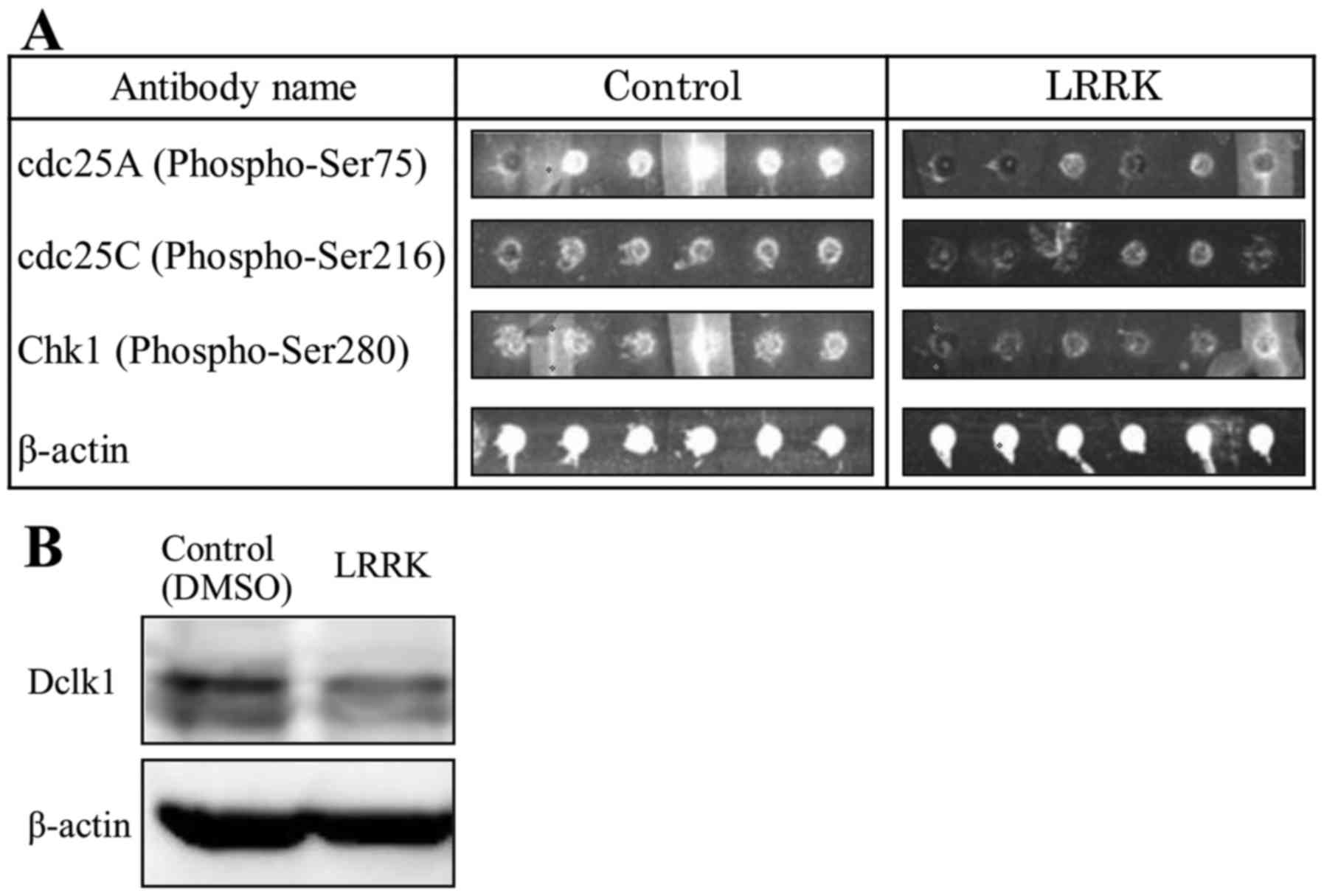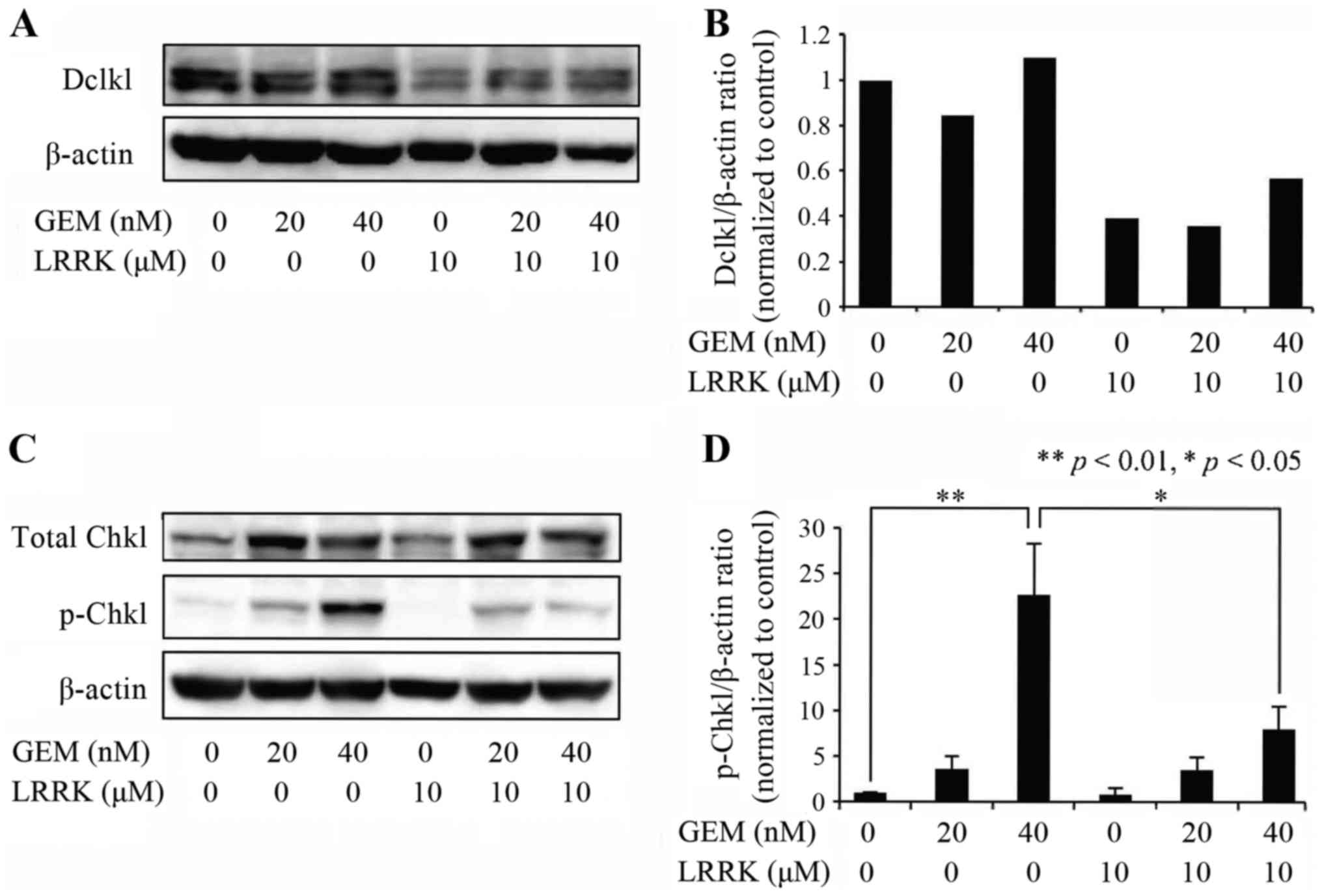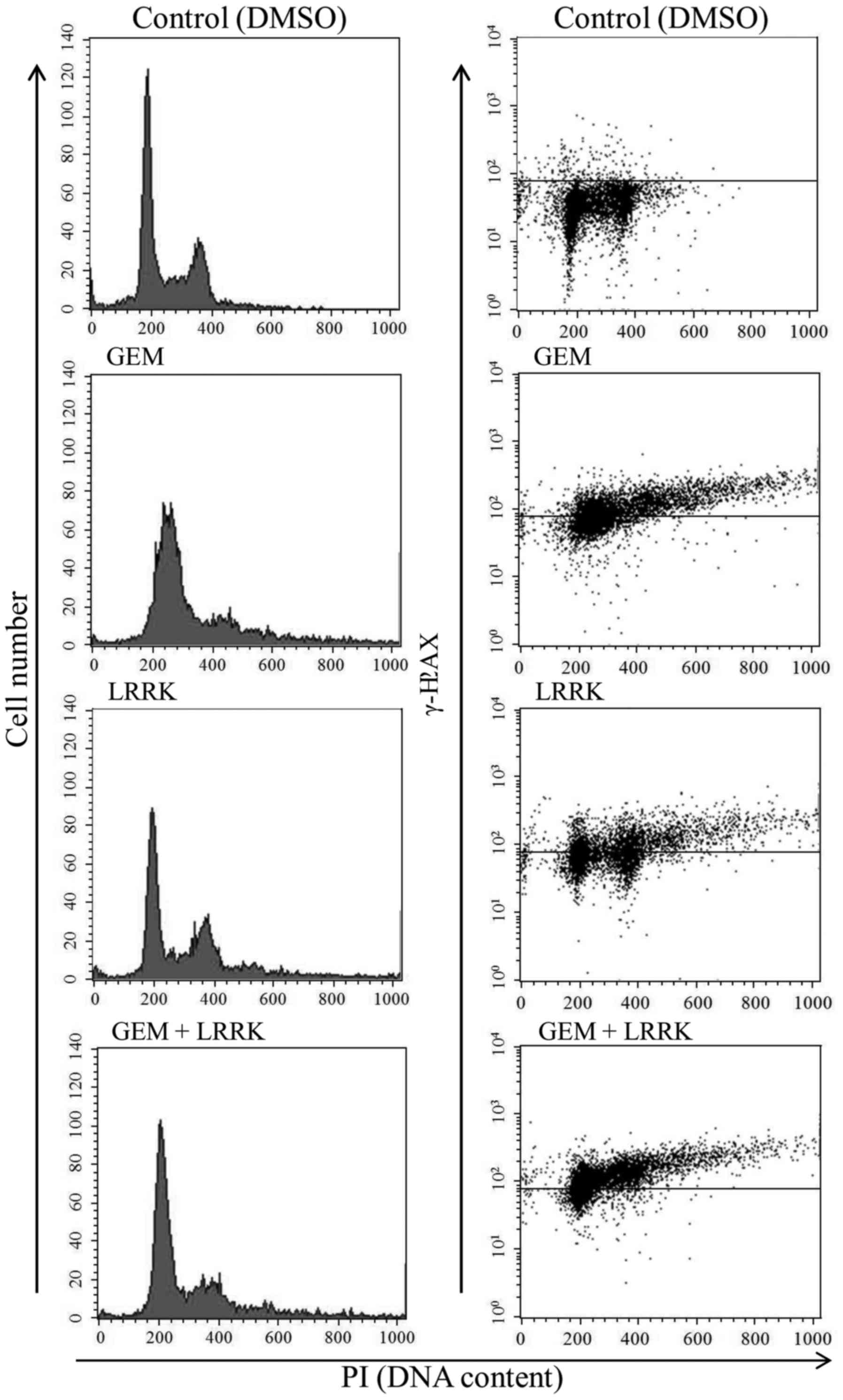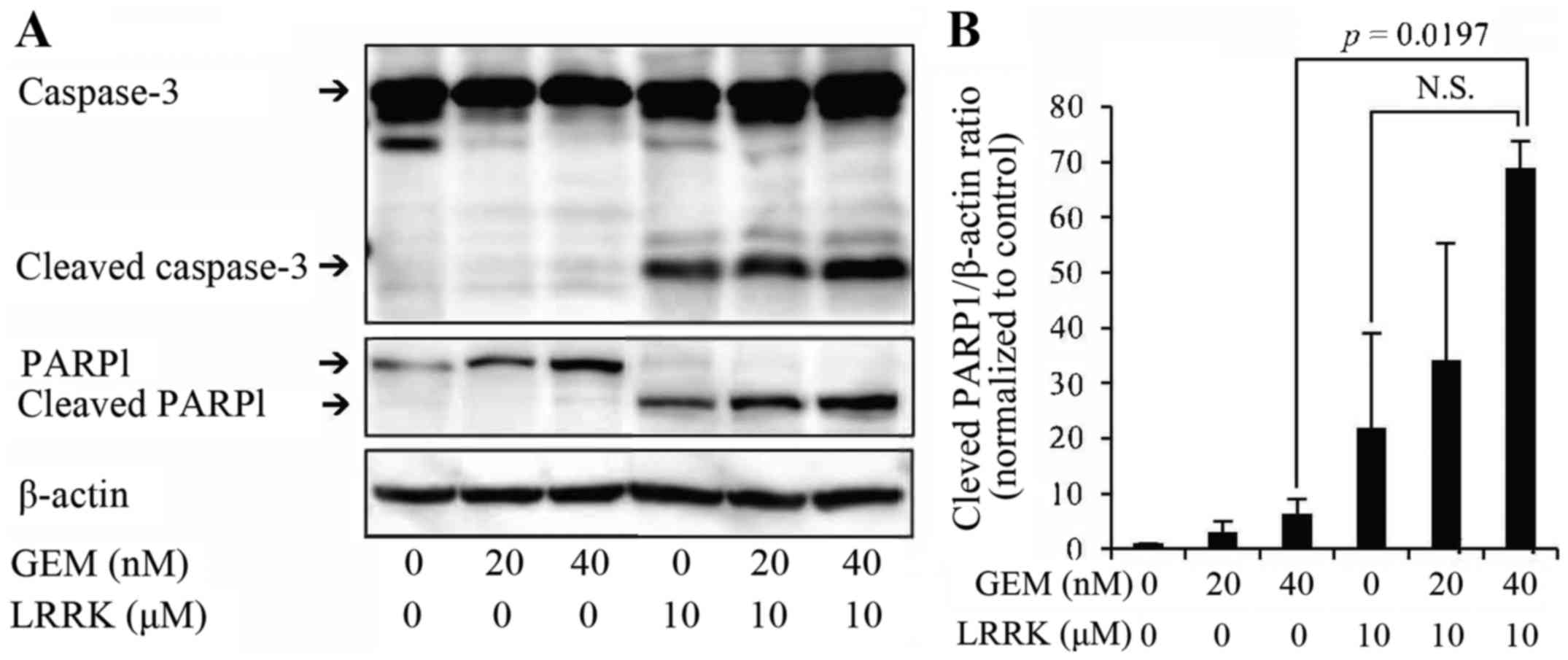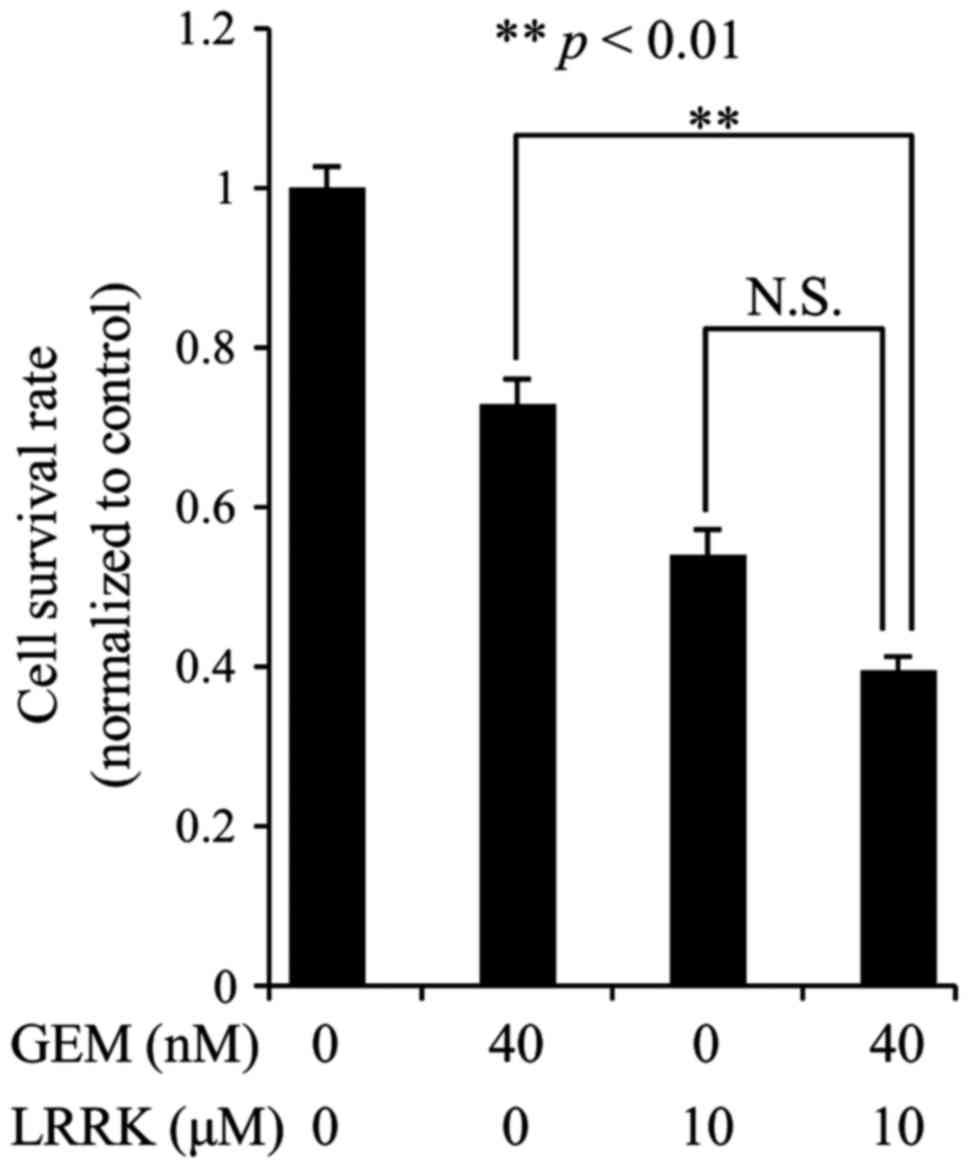|
1
|
Siegel RL, Miller KD and Jemal A: Cancer
Statistics, 2017. CA Cancer J Clin. 67:7–30. 2017. View Article : Google Scholar : PubMed/NCBI
|
|
2
|
Kamisawa T, Wood LD, Itoi T and Takaori K:
Pancreatic cancer. Lancet. 388:73–85. 2016. View Article : Google Scholar : PubMed/NCBI
|
|
3
|
Shi Z, Azuma A, Sampath D, Li YX, Huang P
and Plunkett W: S-Phase arrest by nucleoside analogues and
abrogation of survival without cell cycle progression by
7-hydroxystaurosporine. Cancer Res. 61:1065–1072. 2001.PubMed/NCBI
|
|
4
|
Karnitz LM, Flatten KS, Wagner JM,
Loegering D, Hackbarth JS, Arlander SJH, Vroman BT, Thomas MB, Baek
YU, Hopkins KM, et al: Gemcitabine-induced activation of checkpoint
signaling pathways that affect tumor cell survival. Mol Pharmacol.
68:1636–1644. 2005.PubMed/NCBI
|
|
5
|
Morgan MA, Parsels LA, Parsels JD,
Mesiwala AK, Maybaum J and Lawrence TS: Role of checkpoint kinase 1
in preventing premature mitosis in response to gemcitabine. Cancer
Res. 65:6835–6842. 2005. View Article : Google Scholar : PubMed/NCBI
|
|
6
|
Parsels LA, Morgan MA, Tanska DM, Parsels
JD, Palmer BD, Booth RJ, Denny WA, Canman CE, Kraker AJ, Lawrence
TS, et al: Gemcitabine sensitization by checkpoint kinase 1
inhibition correlates with inhibition of a Rad51 DNA damage
response in pancreatic cancer cells. Mol Cancer Ther. 8:45–54.
2009. View Article : Google Scholar : PubMed/NCBI
|
|
7
|
Venkatesha VA, Parsels LA, Parsels JD,
Zhao L, Zabludoff SD, Simeone DM, Maybaum J, Lawrence TS and Morgan
MA: Sensitization of pancreatic cancer stem cells to gemcitabine by
Chk1 inhibition. Neoplasia. 14:519–525. 2012. View Article : Google Scholar : PubMed/NCBI
|
|
8
|
Montano R, Thompson R, Chung I, Hou H,
Khan N and Eastman A: Sensitization of human cancer cells to
gemcitabine by the Chk1 inhibitor MK-8776: Cell cycle perturbation
and impact of administration schedule in vitro and in vivo. BMC
Cancer. 13:6042013. View Article : Google Scholar : PubMed/NCBI
|
|
9
|
Koh SB, Courtin A, Boyce RJ, Boyle RG,
Richards FM and Jodrell DI: CHK1 inhibition synergizes with
gemcitabine initially by destabilizing the DNA replication
apparatus. Cancer Res. 75:3583–3595. 2015. View Article : Google Scholar : PubMed/NCBI
|
|
10
|
Barnard D, Diaz HB, Burke T, Donoho G,
Beckmann R, Jones B, Barda D, King C and Marshall M: LY2603618, a
selective CHK1 inhibitor, enhances the anti-tumor effect of
gemcitabine in xenograft tumor models. Invest New Drugs. 34:49–60.
2016. View Article : Google Scholar : PubMed/NCBI
|
|
11
|
Seto T, Esaki T, Hirai F, Arita S, Nosaki
K, Makiyama A, Kometani T, Fujimoto C, Hamatake M, Takeoka H, et
al: Phase I, dose-escalation study of AZD7762 alone and in
combination with gemcitabine in Japanese patients with advanced
solid tumours. Cancer Chemother Pharmacol. 72:619–627. 2013.
View Article : Google Scholar : PubMed/NCBI
|
|
12
|
Sausville E, Lorusso P, Carducci M, Carter
J, Quinn MF, Malburg L, Azad N, Cosgrove D, Knight R, Barker P, et
al: Phase I dose-escalation study of AZD7762, a checkpoint kinase
inhibitor, in combination with gemcitabine in US patients with
advanced solid tumors. Cancer Chemother Pharmacol. 73:539–549.
2014. View Article : Google Scholar : PubMed/NCBI
|
|
13
|
Daud AI, Ashworth MT, Strosberg J, Goldman
JW, Mendelson D, Springett G, Venook AP, Loechner S, Rosen LS,
Shanahan F, et al: Phase I dose-escalation trial of checkpoint
kinase 1 inhibitor MK-8776 as monotherapy and in combination with
gemcitabine in patients with advanced solid tumors. J Clin Oncol.
33:1060–1066. 2015. View Article : Google Scholar : PubMed/NCBI
|
|
14
|
Doi T, Yoshino T, Shitara K, Matsubara N,
Fuse N, Naito Y, Uenaka K, Nakamura T, Hynes SM and Lin AB: Phase I
study of LY2603618, a CHK1 inhibitor, in combination with
gemcitabine in Japanese patients with solid tumors. Anticancer
Drugs. 26:1043–1053. 2015. View Article : Google Scholar : PubMed/NCBI
|
|
15
|
Calvo E, Braiteh F, Von Hoff D, McWilliams
R, Becerra C, Galsky MD, Jameson G, Lin J, McKane S, Wickremsinhe
ER, et al: Phase I study of CHK1 inhibitor LY2603618 in combination
with gemcitabine in patients with solid tumors. Oncology.
91:251–260. 2016. View Article : Google Scholar : PubMed/NCBI
|
|
16
|
Goto H, Izawa I, Li Ping and Inagaki M:
Novel regulation of checkpoint kinase 1: Is checkpoint kinase 1 a
good candidate for anti-cancer therapy? Cancer Sci. 103:1195–1200.
2012. View Article : Google Scholar : PubMed/NCBI
|
|
17
|
Lin PT, Gleeson JG, Corbo JC, Flanagan L
and Walsh CA: DCAMKL1 encodes a protein kinase with homology to
doublecortin that regulates microtubule polymerization. J Neurosci.
20:9152–9161. 2000.PubMed/NCBI
|
|
18
|
Omori Y, Suzuki M, Ozaki K, Harada Y,
Nakamura Y, Takahashi E and Fujiwara T: Expression and chromosomal
localization of KIAA0369, a putative kinase structurally related to
Doublecortin. J Hum Genet. 43:169–177. 1998. View Article : Google Scholar : PubMed/NCBI
|
|
19
|
Mohammed A, Janakiram NB, Madka V, Brewer
M, Ritchie RL, Lightfoot S, Kumar G, Sadeghi M, Patlolla JMR,
Yamada HY, et al: Targeting pancreatitis blocks tumor-initiating
stem cells and pancreatic cancer progression. Oncotarget.
6:15524–15539. 2015. View Article : Google Scholar : PubMed/NCBI
|
|
20
|
Sureban SM, May R, Qu D, Weygant N,
Chandrakesan P, Ali N, Lightfoot SA, Pantazis P, Rao CV, Postier
RG, et al: DCLK1 regulates pluripotency and angiogenic factors via
microRNA-dependent mechanisms in pancreatic cancer. PLoS One.
8:e739402013. View Article : Google Scholar : PubMed/NCBI
|
|
21
|
Sureban SM, May R, Lightfoot SA, Hoskins
AB, Lerner M, Brackett DJ, Postier RG, Ramanujam R, Mohammed A, Rao
CV, et al: DCAMKL-1 regulates epithelial-mesenchymal transition in
human pancreatic cells through a miR-200a-dependent mechanism.
Cancer Res. 71:2328–2338. 2011. View Article : Google Scholar : PubMed/NCBI
|
|
22
|
Ito H, Tanaka S, Akiyama Y, Shimada S,
Adikrisna R, Matsumura S, Aihara A, Mitsunori Y, Ban D, Ochiai T,
et al: Dominant expression of DCLK1 in human pancreatic cancer stem
cells accelerates tumor invasion and metastasis. PLoS One.
11:e01465642016. View Article : Google Scholar : PubMed/NCBI
|
|
23
|
Sureban SM, May R, Weygant N, Qu D,
Chandrakesan P, Bannerman-Menson E, Ali N, Pantazis P, Westphalen
CB, Wang TC, et al: XMD8-92 inhibits pancreatic tumor xenograft
growth via a DCLK1-dependent mechanism. Cancer Lett. 351:151–161.
2014. View Article : Google Scholar : PubMed/NCBI
|
|
24
|
Weygant N, Qu D, Berry WL, May R,
Chandrakesan P, Owen DB, Sureban SM, Ali N, Janknecht R and Houchen
CW: Small molecule kinase inhibitor LRRK2-IN-1 demonstrates potent
activity against colorectal and pancreatic cancer through
inhibition of doublecortin-like kinase 1. Mol Cancer. 13:1032014.
View Article : Google Scholar : PubMed/NCBI
|
|
25
|
O'Connell MR, Sarkar S, Luthra GK, Okugawa
Y, Toiyama Y, Gajjar AH, Qiu S, Goel A and Singh P: Epigenetic
changes and alternate promoter usage by human colon cancers for
expressing DCLK1-isoforms: Clinical implications. Sci Rep.
5:149832015. View Article : Google Scholar : PubMed/NCBI
|



